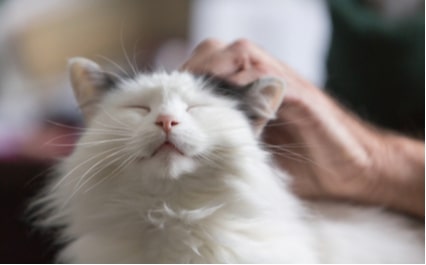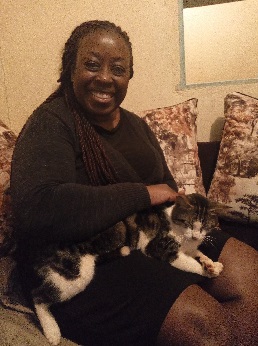
Have you ever heard that cats are talkative? When a cat purrs or meows, they are talking to you. My tabby, Sophia, has conversations with us all the time. So much so that my family members and I decided to try and understand what she was saying to us when she meows or purrs a certain way.
A cat’s meow tells you it is lonely and wants some TLC. Cats also meow when ill. Older cats also tend to meow more because of anxiety due to failing senses or poor mobility. Purring, on the other hand, means the cat is content. However, sometimes the cat has a worry-purr when nervous or agitated.
Meow sounds vary in tone, volume, and length. Below are five reasons for cat vocalizations.
1. The cat is sick
Your cat vocalizes to let you know that all is not right. Cat diseases that cause the cat to feel thirsty, pain, or any other discomfort will cause it to meow as it seeks your attention.
Just like infants and toddlers cry when sick because they feel terrible, cats also meow for the same reason. If you have tried to meet all your other cat’s needs, but it is still meowing, visit the vet to rule out illness.
2. The cat is stressed
Stress can cause the cat distress, and to express their uncertainty, it will meow. For example, you may have moved houses or introduced a new pet into your home.
Even a change in the cat’s daily routine can cause the cat to feel anxious. Cat parents also report more anxiety in their cats during the holiday season, which results in more meows.
That especially occurs during loud holidays like Fourth of July with the fireworks, Halloween with the constantly ringing doorbell during trick-or-treating and house parties with loud music and talking.
3. It is mating season

The mating season comes with a very distinct meow which is known as a yowl. This sound reminds me of a tortured ghost. My tabby gets into a state around March through into September as I have not had it spayed.
Yowling sounds like a throaty, low moan that has been drawn out. This meow is meant for fellow cats in the vicinity, and it says, “I am ready to mate.”
If you hear this meow, it is best to take your cat to a well-selected male for mating. You cannot ignore a yowl because your feline will become a nightmare to live with. It is not uncommon for the cat in heat to tear through screen doors or go to other extreme lengths to get to a male or female for mating.
The female will yowl when in heat, while the male cat yowl when he smells a female in heat. If you have lived through a yowling fest outside your window like me, you know it is best to get your cat attended to promptly.
If you do not want kittens, it is best to get your cat neutered or spayed.
4. Because it is nighttime
Ah yes, the midnight meow. Before you blow your top, this type of meow is just your feline friend seeking reassurance that you are still around and haven’t left it behind.
Also, if your cat wasn’t active enough during the day, it may not be tired enough to sleep, so it meows to get your attention because it is bored. And its nighttime meow may sound louder because everyone else is asleep.
Finally, hunger may also cause your cat to meow at night. So do not give your cat its last meal too early in the day.
5. It is showing affection
Cats greet their surrogate human family members with a meow. That signifies that the cat has seen you and acknowledges your presence.
Their hello is brief and medium-pitched. They do it will little interest or effort, but it means the world to the cat saying it to you. It means the cat loves you and is happy to see you. You usually get this meow when the cat sees you after you have been absent for a couple of hours.
The Reasons for Purring

When it comes to purrs, there are two reasons for a cat purring: Contentment and stress.
Many people just assume that a purring cat is a happy cat. That is not always the case.
1. The happy purr
This is when the cat is in your lap for a cuddle or is about to fall asleep in a warm bed, with a belly full. The cat can barely keep its eyes open, and it is calm and relaxed.
2. The stressed purr
The stressed purr shows up when the cat is in pain, hurt or anxious. It is a self-soothing instinctive reaction, like a child sucking their thumb, that helps the cat cope with the stress of the moment.
Some owners have observed that their cats purr when visiting a vet due to stress. According to veteran BBC cat photographer, Marjan Debevere, cats sometimes purr when dying or being put down.
3. The connection purr
Speaking of soothing, a mother and her kittens use the purr to let each other know they are okay or where to find the other. Mama uses it as a lullaby to soothe her kittens to sleep.
Interestingly, research has shown that purring can help cats heal their bones. The sound frequency of the purrs, which is between 25 – 150 hertz, improves feline bone density while promoting healing.
A cat purrs by rapidly moving the voice box (larynx) muscles and the diaphragm muscles. Your feline moves these muscles up to 30 times per second as the cat breathes. The air comes into contact with the vibrating muscles emitting a purr in the process.
Keen cat parents have learned to decipher their cat’s purrs. They report:
The fast and the furious purr: This is the purr you get when you have been away, and the cat finally has its first snuggle or cuddle of the evening with you. It feels like your feline can’t get enough of your touch, and it keeps glancing up at you like it is saying, “Don’t ever stop.”
It shows complete trust and love.
The combo purr: This purr combines the meow sound right in the middle of the purring. The meow may sound gravelly because it is affected by the purr. It usually shows us in the middle of the fast and furious purr.
The barely-there purr: With this purr, you can almost feel the rumble, but it is so far off that it could be just a murmur. The purr is emitted by a very light larynx action that gives it a softer than usual quality. Sometimes you may not be sure the cat is purring.
This purr is mostly felt when the cat is completely relaxed and very content.
The drooly purr: It is a wet purr as suggested by the name. The cat drools as it purrs because it is content and relaxed. This type of purr carries over from the cat’s kitten days and nursing.
You may notice that apart from drooling, the cat is kneading its paws. Kittens place their paws on their mothers and knead to stimulate milk production.
Your cat is at a happy place and a state of total relaxation when they knead and purr. The relaxation may cause their mouth muscles to go slack a bit and release a bit of saliva. It is common in heavy purrers.
The hello purr: This is the purr that greets you when you walk into the cat’s space. For example, the cat may be snoozing on the chair, and you walk past only to hear a low rumble. The cat senses your presence and acknowledges you without moving a muscle.
It says, “Hi, how are you. I know you are there, but I am not waking up from here. Glad to see you though.”
The cat could be hidden in a nook napping but will emit this purr when you walk in. It lets you know the cat is in the vicinity even though you can’t see it.
Sound Patterns to Expect From Cats
There are four categories of cat sounds that every cat owner should become conversant with. They form a pattern of sounds that defines each category:
1. The vowel pattern:
This is the type of meowing most cat owners respond most to. It comes in different variations. Here is a breakdown of the vowel meows:
The single meow: this is the standard feline greeting. It is a short meow or mew sound.
The series of meow: these meows signify excitement. They are likely to greet you the minute you walk into the house. Usually, such meows do not seem to have a full stop, and the cat follows you around the house until you acknowledge it.
The low-pitch meow: It sounds like a “mmrrrooow” and it is accusatory. If you hear this meow, you have done something that the kitty is not happy about but not unforgivable.
The hungry meow: It is medium-pitched, and the cat will continue to emit it until you feed it.
The drawn-out meow: This is another “mrroowww” but it is more elongated and almost mournful. It means your cat wants something like open the door or give me a toy.
The angry meow: It is very high pitched and is typically followed by an agitated stand by the cat. For example, you may step on the cat’s tail when this meow appears.

2. The murmur pattern:
This pattern is made up of trills and purrs. The trills are repetitive and high-pitched noises that the cat emits in short bursts.
Your cat emits trilling sounds with its mouth closed, unlike its other forms of vocalizations. It is considered a form of meow because the cat vocalizes even with its mouth closed.
Think of this as your cat’s way of muttering under its breath, but it is not out of frustration. Instead, it mutters to express contentment and affection.
Sometimes the muttering is so low that it comes out as a purr.
3. The strained patterns:
The strained patterns come out when the cat is under intense agitation, like imminent attack or fear. These sounds are typical hisses and growls.
They signify that the cat is ready to defend itself and can be a danger to you and other animals around it because of redirected aggression.
Redirected aggression is when your cat is agitated or aggrieved by another person or animal but lashes out at you or another innocent animal if you approach. Typically, the cat is unable to reach the source of its aggression, but you may reach out at that moment and unfortunately become the target of its wrath.
Fortunately, the cat gives you fair warning using strained intensity patterns like growling or hissing before it acts out in redirected aggression.
Strained sounds do not only occur during redirected aggression, but anytime the cat feels under attack. But the good news is that cats don’t go out looking for a fight or someone to attack.
4. The articulated pattern:
These types of sound express frustration, especially when they can’t reach something that excites them. For example, your feline may see a squirrel or bird through the window and want to get to it but cannot reach it.
The cat will chatter in excitement and also frustration at not being able to get to the bird/squirrel. It is essential to remember that your cat still has a prey drive despite being domesticated.
It wants to chase and catch “prey,” and even if it won’t eat it, it will bring the dead animal or bird to you as a “gift.”
When Cat Meowing and Purring becomes Excessive

First, let us define excessive meowing versus the usual meowing. What I have described above is regular meowing that you can expect with your cat. Excessive meowing, on the other hand, is continuous and doesn’t abate until the cat finds some relief. It increases in frequency, pitch and intensity. Here are the reasons why.
1. Loss of a friend
Cats that have lost a feline friend or kitten may walk around the house meowing excessively as they search for their lost companion or baby.
They also exhibit this behavior when they lose their human parent or even a close canine companion.
The excessive meowing may continue for weeks until the cat finally comes to terms with the loss. If your cat continues to meow excessively and can’t come out of its state of loss, consider medical therapy.
Medical therapy can be in the form of medication or behavior modification techniques by cat professionals.
2. A bad habit
This could be a learned behavior that your cat uses to get its way. That is a terrible habit that wasn’t curtailed when it should have been, and now your cat uses it whenever you deny it something.
The cat has learned that if it meows long enough, it will wear you out, and you will eventually give in to its demands to shut it up. Smart yet bad kitty!
If you want to curb this behavior, stop giving the cat the attention it seeks when it keeps meowing. But once the cat goes quiet, give it the attention. Continue withholding attention during excessive meowing and giving it when the cat is quiet, and it will soon learn the new rhythm.
3. Due to long solitary periods
Contrary to the popular belief that cats love solitude, cats miss their owners when away from them. So, when you come home from work, expect a whole lot of excited meows as your feline friend says hi, asks how you are and how your day was all at the time.
It is a beautiful thing to experience when Sophia can’t wait for me to even get in through the door before she passes under my legs and looks at me with those beautiful gray eyes.
I can’t tell you how many times I have tripped over her while trying to get through and respond to her meows.
To a cat, your day-long absence is significant enough to warrant a series of meows to greet your return. Bask in them and reciprocate with a light petting to return the favor. Cats do not like being on their own for long periods.
4. Due to certain diseases
Some diseases like kidney disease or an overactive thyroid in cats can result in excessive meowing.
Hyperthyroidism in cats causes increased hunger, thirst, and urination which are extremely uncomfortable for the feline. That explains why the cat constantly meows.
Kidney disease in cats causes diarrhea, vomiting, dehydration, and weakness. Nausea and constant loose stool may cause the cat to meow continually as the symptoms do not abate.
Also, cognitive dysfunction in your feline friend may result in excessive meowing because the cat is increasingly confused, disoriented, and unaware of its surroundings (even home). This condition is similar to dementia in human beings.
5. They want to chat
You may be home, but you are busy and can’t give your kitty the attention it wants. To get your attention, it may meow excessively to get you to play or pet it.
Consider getting interactive toys like the SnugglyCat the Ripple Rug , which is an activity play mat for cats. When you are busy, your cat can also be busy playing.
Remember that bored cats can become destructive. But with something to take their attention, they quickly become immersed and even forget about you.
Teach Your Cat to Be Less Vocal
An overly vocal cat can be an irritant, especially if it is not ill or grieving. The good news is that you can identify the triggers that cause your kitty to become too vocal. Also, figure out what makes the meows stop.
Train your cat to talk less by
1. Giving due attention

It is best not to form a habit of ignoring your cat. Cats are discerning creatures, and if you continue to ignore them, they will also learn to ignore you.
The bond that you share becomes weaker and weaker, and your cat may even wander off and find someone more loving towards it to attach itself to.
And, to be fair, in most cases, your cat’s insistent meows have a valid reason. For example, it may not have access to its litter box, may be locked in a room, or the water bowl is empty.
When the cat initiates a chat by meowing, acknowledge the meow with a pat and check first to see what’s wrong.
However, do not encourage it to demand your attention by meowing constantly if the cat just has a bad habit of continuously vocalizing.
If your kitty does that, ignore it just until it stops the meowing and then give it some attention. If it goes back to meowing, repeat this training until your cat associates attention with quiet behavior rather than meowing.
Even angry attention is still attention to your cat. So, if your feline friend meows constantly and in irritation, you shout at it, then it has achieved its goal: which was to get your attention.
Do not get baited into angry attention. Keep calm and withhold all and any attention until the cat stops meowing, then shower it with attention. It will soon learn the lesson there.
2. Getting a pet sitter
Just like dog owners get dog walkers to ensure their canines have enough exercise if they can’t do it themselves, a pet sitter will ensure that your cat doesn’t feel lonely when you are away from home.
The pet sitter can come for a few hours in the day when you are at work and play with your cat. That alleviates boredom and provides your cat with the mental stimulation it needs.
So, when you come home, it is not craving human attention so bad that it becomes your shadow everywhere you go while meowing.
3. Feeding on time

Do not withhold food and water from your cat. That is cruel, and it causes the cat to lose trust in humans. If it persists, your cat may turn wild and feral, and its chances of surviving out there reduce significantly.
Having said that, it is critical to ensure that you feed your cat at the scheduled time. The best times to feed your cat are at dawn and dusk because these are their instinctive hunting times of the day if they were in the wild.
That means that your cat becomes used to having specific feeding times. So, your cat will not be demanding food with continuous meows at just any time of the day.
You can give a treat occasionally but do not make it a consistent expectation in the cat’s day.
Feeding on time also builds trust in your feline that you care and you will meet your obligation of feeding it. Also, make sure that you feed the cat enough quantity so that the animal doesn’t get hungry too soon.
Some people like to buy their cats an automatic food dispenser that dispenses food at certain times of the day. So, it takes the pressure off you while also teaching the cat to expect its food at particular times.
For other people, feeding their cats in the evening is easier because of the hectic morning schedule. They may leave smaller meals in the dispenser or a treat puzzle for the cat to eat from throughout the day before the main evening meal.
4. Giving a bit of freedom
Some cats are both outdoor and indoor pets. They like to go and climb the tree in the yard and then come back home for food and a cuddle with you.
Install a cat door to allow the feline its freedom so that when it wants to go out for a spell, it doesn’t meow your ear off to let it out.
Letting your cat out of the house makes it happy. The opposite is closing the doors and windows, and your cat looks longingly outside out of frustration.
Talkative Cat Breeds Known for Purring and Meowing a Lot
Researchers have found that cat vocalization is more for communication between felines and their human companions and not feline to feline communication. Some breeds tend to meow more than others. Check out some of these friends
The American Bobtail

This is a very friendly and intelligent cat that thrives on learning new things. It loves puzzles and even plays fetch.
When happy it will talk to you in chirps and trills in addition to the standard meows and purrs.
They have a soft, pleasant voice making their long melodious meows and short chirps and trills quite palatable. This breed loves to strike up conversations with you the minute you walk through the door.
Their gentle nature combined with a love for talking makes them a great fit for a multiple pet household and a home with kids.
The American Bobtail is not as continuously vocal as other breeds, but it does like to communicate and have a conversation with you. You can expect more chirps and trills as opposed to meows.
The Siamese

The Siamese cat is well known for being very vocal. It is a social breed that loves attention and will talk your ear off to get it.
Siamese cats also have a reputation for being demanding characters. So, if you are getting one expect a little boss with a tendency of talking to you, and when it doesn’t get its way, the volume of the meows goes up significantly.
Siamese cat owners have said these cats meow like a crying baby. And these cats don’t back down either when they get into a meowing rampage.
The reason they are so vocal is that Siamese cats are very social and love to be around people. They appreciate it when you talk back, so their owners have to be comfortable with kitty speak.
These cats will follow their owners around the house while having a conversation. If left alone too often or ignored, they can develop depression or become overly aggressive just before you leave. This is due to separation anxiety syndrome.
The Balinese-Javanese

This exotic breed came about because of a spontaneous genetic mutation in Siamese purebreds. Some Siamese cats develop longer coats that feature heavier fur because of the mutation.
Their name confuses many people to think they originated from Bali. Not at all.
Their only connection with Bali in Thailand is being named after the graceful dancers of the temples of Bali due to their graceful personality and elegant gait.
Apart from their grace, the breed is highly intelligent and social like the Siamese and also talkative. However, it is essential to note that the Balinese-Javanese conversations are softer and less aggressive.
The Bengal
The Bengal has a reputation for being an attention seeker so you can expect it to want hugs and long chats. These cats love to let you know how they feel about you, their day, and the annoying cat next door.
You can expect Bengal cats to talk to you using chirps, trills, purrs, and meows. And they just love it when you talk back.
Also, Bengal cat owners have reported very loud yowls from their kitties.
Now, this breed is a prolific climber, just like its ancestors, the leopard. So, you can expect it to climb to its perch and talk to you from up there. Perch conversations mean the cat is at its most comfortable and ready to catch up with you.
These cats respond to everything that you say with a meow.
If you like a talkative cat, consider a Bengal. Even as they age, their affinity for conversation does not dissipate.
The Ocicat
Another descendant of the Siamese cat is the Ocicat. They also inherited their ancestors’ vocal tendencies, although they are also soft-spoken and less disruptive.
They will respond to their names and learn to perform tricks on command, which tells you these cats are highly intelligent. However, Ocicats tend to bond with only one person in the family, and that person becomes their conversation partner.
That makes them a good fit for a single pet household with one owner or a maximum of two. If you have to leave them alone, find an animal companion to keep the cat company.
You will notice that their voices are smoother, lacking the heavy rasp you might detect in a Siamese cat’s voice. While they are happy to tell you, they are not overly insistent in the conversation.
An Ocicat talking is pleasant because its voice is not high-pitched.
A distinct behavior in Ocicats is that they are accommodating of visitors in your home. They will greet you at the door, and if you have a visitor with you, they will be greeted too.
But when it comes to talking, your cat will direct all its conversations to you and completely ignore the visitor.
The Sphinx
This cat appears aloof, but they are chatterboxes. You can expect never to have a dull moment with this breed.
Sphinx cat owners have said that their cats surprise them by sounding like they are actually talking to them over and above the standard cat meows and purrs. That means when you say something they reply back like they understood and understand your meaning.
The expression on their faces also makes it look like they completely understand the words coming out of your mouth. They make an excellent pet for people who like to rant and rave but have no one to talk to.
Sphinxs have also been reported to be demanding cats that like to have your attention. So, their meows range from asking for food to just wanting to chat and catch up.
And they talk to everyone from their kittens to birds outside and everyone else in the home.
Sphinx cats are highly social animals that should not be left alone for long periods. Like Siamese, they can develop separation anxiety syndrome if you ignore them.
Get a dog or another cat to keep them company because they can adapt to having someone to talk to in the house (even if the other party doesn’t answer back).
The Burmese
A Burmese is often mistaken for a Siamese, but they are separate breeds. One distinct difference is in their vocalization.
The Siamese has a sharper voice, while the Burmese cat has a lower voice that sounds like an intimate call. The Burmese call is very chilled out, but it can get insistent if you do not attend to it.
Owners who like to talk to their cat but would rather not have a high-pitched meow everywhere they turn will find the low rumble of the Burmese much friendlier.
The Maine Coon
This breed is notorious for being super vocal. But owners say that although they talk a lot, they are not loud talkers.
There is a lot of trilling and chirping with this breed and less meowing. If your Maine coon is meowing a lot, that is a distinct sign that something is very amiss with the cat.
Their trilling and chirping may be on the higher side because they have a high-pitched voice. But don’t worry, listening to them talk is pleasant.
Listening to a Maine coon cat is like listening to a kitten. They tend to sound like kittens all their lives which is interesting because they are the largest domesticated cat breed.
Final Thoughts
When it starts deep in the cat’s chest and revibrates all over your little chap’s body so that it appears the cat is set on vibrate, that is a cat’s purr. Sweet and reassuring.
The meow, on the other hand, is vocal; More like the cat saying something to you.
Do not hit your cat or scold it for meowing. First of all, hitting or shouting at the cat is unlikely to change the meowing behavior. However, it does affect how much your cat trusts you and instill fear in your feline friend.
Oriental breeds appear to be the most vocal cats. They love to have conversations and can be demanding.
Whichever breed of cat you have, do not ignore it when it meows. Find out why before dismissing it as bad behavior.
And remember, when your cat is happy, it will also meow and, of course, reward you with a purr as well.
Writer: Mercy Nandika Amatieku
